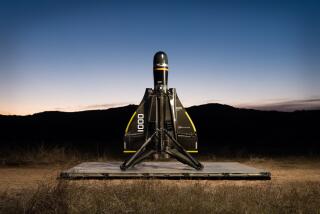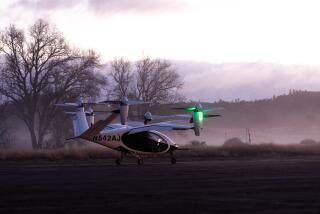NASA Tests Prototype of Electric-Powered ‘Flying Yardstick’
- Share via
EDWARDS AIR FORCE BASE — A 206-foot-long unmanned flying wing driven by 14 electrically powered propellers climbed into the sky Thursday on a flight to test technology intended to allow it to climb to 100,000 feet on the sun’s energy.
The flight of the robotic Centurion, directed by a pilot on the ground, went very well, said Pete Jacobs, a spokesman for the builder, AeroVironment. It was in the air about two hours and climbed to an altitude of a few hundred feet.
If development continues as planned, Centurion will eventually carry atmospheric research instruments 19 miles above the Earth.
Spinoff designs might someday serve the same functions as satellites, staying aloft day and night for extended periods far more cheaply than spacecraft.
With a wingspan bigger than a Boeing 747’s, Centurion is a leap in scale over predecessors developed for the National Aeronautics and Space Administration.
Compared to a “yardstick flying sideways,” it weighs 1,175 pounds and is expected to cruise at speeds of 17 mph to 21 mph. Eventually the power will come from solar cells. For now, it runs on batteries.
Constructed of low-weight materials including carbon fiber, Kevlar, Styrofoam and plastic film, Centurion is being developed under NASA’s Environmental Research Aircraft and Sensor Technology program at the Dryden Flight Research Facility.
More to Read
Sign up for Essential California
The most important California stories and recommendations in your inbox every morning.
You may occasionally receive promotional content from the Los Angeles Times.












